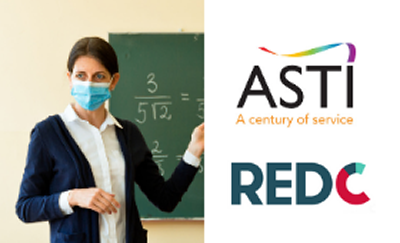
Rebuilding school communities: Smaller classes, increased access to mental health services essential, say teachers
Smaller classes, reduced teacher workload, and improved access to youth mental health services are essential to rebuilding school communities post-pandemic, a survey of second-level teachers has found.
Sixty-three per cent of teachers who responded to the ASTI/ RED C survey believe smaller classes are fundamental to supporting teachers’ work post-pandemic. Other priorities include reducing teacher workload and more supports for students with emotional and behavioural difficulties.
“Smaller class size is identified by the majority of teachers as the priority area for investment post-pandemic,” said ASTI President Ann Piggott today (Wednesday, March 31). “We know from research carried out last year that the majority of Junior Cycle classes are above the EU and OECD class size averages. This means that many students are not getting the individual attention they deserve. Differentiated teaching, which is the foundation of inclusive education, is problematic in overcrowded classes. Large class sizes also impede the use of diverse teaching methodologies which are very much required for teaching the Framework for Junior Cycle.”
Concerns for student wellbeing
Student wellbeing is a key concern for teachers and school leaders in 2021. Fifty-seven per cent of teachers and principals said access to dedicated mental health services outside of school is essential for students to be well and effective learners; 49% of teachers said the augmentation of guidance counselling services within schools is also necessary. Another key priority is training for teachers in how to better support students with emotional and behavioural disorders.
“What teachers are saying is that there can be no business as usual when our schools re-open,” said the ASTI President. “Before the pandemic, Ireland came last out of 36 countries for investment in second-level education as a percentage of GDP*. This gross underfunding of our schools needs to be rectified. Young people have experienced significant school closures, uncertainty about exams, emotional upheaval, digital poverty, changes to family circumstances and more. We need to do much better for our young people post-pandemic. We must build school communities which are more resilient and supportive than ever before.”
Lessons from lockdown
The provision of IT devices to students is prioritised by teachers as the best way of integrating IT in education. Training for students on how to use IT and software is also a priority. Better broadband in schools and free broadband for students outside of schools would also improve the integration of IT.
The survey was completed by 2,527 second-level teachers and principals in February 2021. This represents a high response rate of 19.5% (sample of 12,969 ASTI members).
ENDS
Click here for Survey.
*OECD Education at a Glance 2020.

